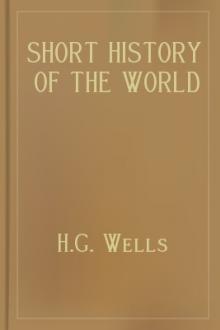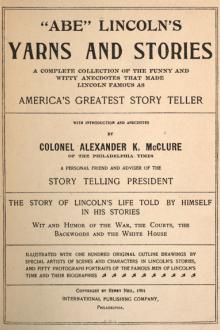A Short History of the World, H. G. Wells [beach books .TXT] 📗

- Author: H. G. Wells
- Performer: -
Book online «A Short History of the World, H. G. Wells [beach books .TXT] 📗». Author H. G. Wells
L THE REFORMATION OF THE LATIN CHURCH
THE Latin Church itself was enormously affected by this mental rebirth. It was dismembered; and even the portion that survived was extensively renewed.
We have told how nearly the church came to the autocratic leadership of all Christendom in the eleventh and twelfth centuries, and how in the fourteenth and fifteenth its power over men’s minds and affairs declined. We have described how popular religious enthusiasm which had in earlier ages been its support and power was turned against it by its pride, persecutions and centralization, and how the insidious scepticism of Frederick II bore fruit in a growing insubordination of the princes. The Great Schism had reduced its religious and political prestige to negligible proportions. The forces of insurrection struck it now from both sides.
The teachings of the Englishman Wycliffe spread widely throughout Europe. In 1398 a learned Czech, John Huss, delivered a series of lectures upon Wycliffe’s teachings in the university of Prague. This teaching spread rapidly beyond the educated class and aroused great popular enthusiasm. In 1414-18 a Council of the whole church was held at Constance to settle the Great Schism. Huss was invited to this Council under promise of a safe conduct from the emperor, seized, put on trial for heresy and burnt alive (1415). So far from tranquillizing the Bohemian people, this led to an insurrection of the Hussites in that country, the first of a series of religious wars that inaugurated the break-up of Latin Christendom. Against this insurrection Pope Martin V, the Pope specially elected at Constance as the head of a reunited Christendom, preached a Crusade.
Five Crusades in all were launched upon this sturdy little people and all of them failed. All the unemployed ruffianism of Europe was turned upon Bohemia in the fifteenth century, just as in the thirteenth it had been turned upon the Waldenses. But the Bohemian Czechs, unlike the Waldenses, believed in armed resistance. The Bohemian Crusade dissolved and streamed away from the battlefield at the sound of the Hussites’ waggons and the distant chanting of their troops; it did not even wait to fight (battle of Domazlice, 1431). In 1436 an agreement was patched up with the Hussites by a new Council of the church at Basle in which many of the special objections to Latin practice were conceded.
(From an early German engraving in the British Museum)
In the fifteenth century a great pestilence had produced much social disorganization throughout Europe. There had been extreme misery and discontent among the common people, and peasant risings against the landlords and the wealthy in England and France. After the Hussite Wars these peasant insurrections increased in gravity in Germany and took on a religious character. Printing came in as an influence upon this development. By the middle of the fifteenth century there were printers at work with movable type in Holland and the Rhineland. The art spread to Italy and England, where Caxton was printing in Westminster in 1477. The immediate consequence was a great increase and distribution of Bibles, and greatly increased facilities for widespread popular controversies. The European world became a world of readers, to an extent that had never happened to any community in the past. And this sudden irrigation of the general mind with clearer ideas and more accessible information occurred just at a time when the church was confused and divided and not in a position to defend itself effectively, and when many princes were looking for means to weaken its hold upon the vast wealth it claimed in their dominions.
In Germany the attack upon the church gathered round the personality of an ex-monk, Martin Luther (1483-1546), who appeared in Wittenberg in 1517 offering disputations against various orthodox doctrines and practices. At first he disputed in Latin in the fashion of the Schoolmen. Then he took up the new weapon of the printed word and scattered his views far and wide in German addressed to the ordinary people. An attempt was made to suppress him as Huss had been suppressed, but the printing press had changed conditions and he had too many open and secret friends among the German princes for this fate to overtake him.
For now in this age of multiplying ideas and weakened faith there were many rulers who saw their advantage in breaking the religious ties between their people and Rome. They sought to make themselves in person the heads of a more nationalized religion. England, Scotland, Sweden, Norway, Denmark, North Germany and Bohemia, one after another, separated themselves from the Roman Communion. They have remained separated ever since.
An allegory of the Church triumphant over heretics and infidels. Italian (Urbino), dated 1543
(In the Victoria and Albert Museum)
The various princes concerned cared very little for the moral and intellectual freedom of their subjects. They used the religious doubts and insurgence of their peoples to strengthen them against Rome, but they tried to keep a grip upon the popular movement as soon as that rupture was achieved and a national church set up under the control of the crown. But there has always been a curious vitality in the teaching of Jesus, a direct appeal to righteousness and a man’s self-respect over every loyalty and every subordination, lay or ecclesiastical. None of these princely churches broke off without also breaking off a number of fragmentary sects that would admit the intervention of neither prince nor Pope between a man and his God. In England and Scotland, for example, there was a number of sects who now held firmly to the Bible as their one guide in life and belief. They refused the disciplines of a state church. In England these dissentients were the Non- conformists, who played a very large part in the polities of that country in the seventeenth and eighteenth centuries. In England they carried their objection to a princely head to the church so far as to decapitate King Charles I (1649), and for eleven prosperous years England was a republic under Non- conformist rule.
The breaking away of this large section of Northern Europe from Latin Christendom is what is generally spoken of as the Reformation. But the shock and stress of these losses produced changes perhaps as profound in the Roman Church itself. The church was reorganized and a new spirit came into its life. One of the dominant figures in this revival was a young Spanish soldier, Inigo Lopez de Recalde, better known to the world as St. Ignatius of Loyola. After some romantic beginnings he became a priest (1538) and was permitted to found the Society of Jesus, a direct attempt to bring the generous and chivalrous traditions of military discipline into the service of religion. This Society of Jesus, the Jesuits, became one of the greatest teaching and missionary societies the world has ever seen. It carried Christianity to India, China and America. It arrested the rapid disintegration of the Roman Church. It raised the standard of education throughout the whole Catholic world; it raised the level of Catholic intelligence and quickened the Catholic conscience everywhere; it stimulated Protestant Europe to competitive educational efforts. The vigorous and aggressive Roman Catholic Church we know to-day is largely the product of this Jesuit revival.
THE Holy Roman Empire came to a sort of climax in the reign of the Emperor Charles V. He was one of the most extraordinary monarchs that Europe has ever seen. For a time he had the air of being the greatest monarch since Charlemagne.
His greatness was not of his own making. It was largely the creation of his grandfather, the Emperor Maximilian I (1459- 1519). Some families have fought, others have intrigued their way to world power; the Habsburgs married their way. Maximilian began his career with Austria, Styria, part of Alsace and other districts, the original Habsburg patrimony; he married—the lady’s name scarcely matters to us—the Netherlands and Burgundy. Most of Burgundy slipped from him after his first wife’s death, but the Netherlands he held. Then he tried unsuccessfully to marry Brittany. He became Emperor in succession to his father, Frederick III, in 1493, and married the duchy of Milan. Finally he married his son to the weak-minded daughter of Ferdinand and Isabella, the Ferdinand and Isabella of Columbus, who not only reigned over a freshly united Spain and over Sardinia and the kingdom of the two Sicilies, but over all America west of Brazil. So it was that this Charles V, his grandson, inherited most of the American continent and between a third and a half of what the Turks had left of Europe. He succeeded to the Netherlands in 1506. When his grandfather Ferdinand died in 1516, he became practically king of the Spanish dominions, his mother being imbecile; and his grandfather Maximilian dying in 1519, he was in 1520 elected Emperor at the still comparatively tender age of twenty.
He was a fair young man with a not very intelligent face, a thick upper lip and a long clumsy chin. He found himself in a world of young and vigorous personalities. It was an age of brilliant young monarchs. Francis I had succeeded to the French throne in 1515 at the age of twenty-one, Henry VIII had become King of England in 1509 at eighteen. It was the age of Baber in India (1526-1530) and Suleiman the Magnificent in Turkey (1520), both exceptionally capable monarchs, and the Pope Leo X (1513) was also a very distinguished Pope. The Pope and Francis I attempted to prevent the election of Charles as Emperor because they dreaded the concentration of so much power in the hands of one man. Both Francis I and Henry VIII offered themselves to the imperial electors. But there was now a long established tradition of Habsburg Emperors (since 1273), and some energetic bribery secured the election for Charles.
At first the young man was very much a magnificent puppet in the hands of his ministers. Then slowly he began to assert himself and take control. He began to realize something of the threatening complexities of his exalted position. It was a position as unsound as it was splendid.
From the very outset of his reign he was faced by the situation created by Luther’s agitations in Germany. The Emperor had one reason for siding with the reformers in the opposition of the Pope to his election. But he had been brought up in Spain, that most Catholic of countries, and he decided against Luther. So he came into conflict with the Protestant princes and particularly the Elector of Saxony. He found himself in the presence of an opening rift that was to split the outworn fabric of Christendom into two contending camps. His attempts to close that rift were strenuous and honest and ineffective. There was an extensive peasant revolt in Germany which interwove with the general political and religious disturbance. And these internal troubles were complicated by attacks upon the Empire from east and west alike. On the west of Charles was his spirited rival, Francis I; to the east was the ever advancing





Comments (0)